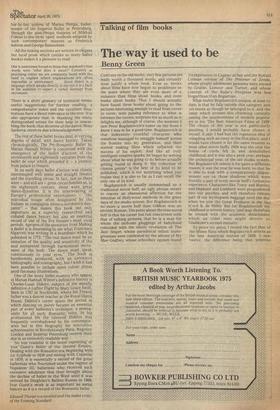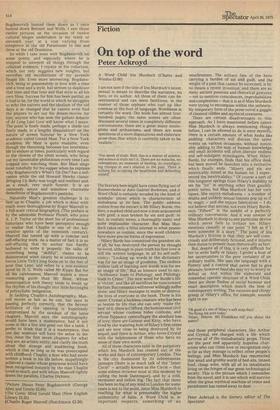The way it used to be
Benny Green
Contrary to the old motto, very few pictures are really worth a thousand words, and virtually none justify a whole book. Even so, books about films have now begun to proliferate to the point where they are even more of a nuisance than films about books, and even books about books. That I should actually have found three books about going to the pictures interesting enough to read from cover to cover, with passing reference to what is between the covers, surprises me as much as it delights me, although of course, the moment I saw Peter Bogdanovich's name on the front I knew I was in for a good time. Bogdanovich is that indecently youthful character Who somehow managed to smuggle himself across the frontier into my generation, and then started making films which reflected the success of his exploit. And like all truly intelligent creative sparks, he began by writing about what he was going to do before actually getting round to doing it. His collection of cinema pieces* is the best of its kind to be published, which is not surprising when you realise that it is also so far as I can recall, the only one of its kind. Bogdanovich is usually summarised as a traditional movie buff, an ugly phrase meant to convey an obsessional affection for the minutiae of Hollywood methods in the great days of the studio system. But Bogdanovich is no more a movie buff than Gibbon was an ancient Roman. The point about the true movie buff is that his career has run concurrent with that of talking pictures, that he is a man for whom the inchoate gluggings 'of babyhood coincided with the idiotic revelation of The Jazz Singer, whose paradisical infant transgressions were celebrated by the advent of My Man Godfrey, whose schoolboy egoism found its expression in Cagney at bay and the Ronald Colman version of The Prisoner of Zenda, whose pimply adolescent passions were roused by Grable. Lamour and Turner, and whose concept of the Rake's Progress .was less Hogarthian than Bogartian.
What makes Bogdanovich unique, at least to date, is that he falls outside this category and yet reacts as though he belonged to it. and the essay which stresses this charming curiosity among the anachronisms of modern popular art is his 'The Best American Films of 1939'. The choice of the year is not particularly puzzling. I would probably have chosen it myself, if only I had had the ingenious idea of compiling such an essay in the first place, and I would have chosen it for the same reasons as most other movie buffs. 1939 was the year the house of cards fell in and demolished childhood, and it was also a peak year, perhaps the archetypal year, of the old studio system. But Bogdanovich selects it for quite a different reason; it was the year he was born, so that he is able to look with a comparatively dispassionate eye on those shadows which were literally a part of every movie buff's formative experience. Characters like Tracy and Rooney and Hepburn and Lombard were programmed into our psyches, and will therefore remain part of our mythopaeic baggage until the day when we join the Great Producer in the Sky (Cecil B. de Mille). But for Bogdanovich my childhood is remote history, and may therefore be treated with the academic detachment which an older man might devote to Gladstone's second ministry.
To prove my point, I record the fact that of the fifteen films which Bogdanovich selects as the best American movies of 1939, I saw twelve, the difference being that whereas Bogdanovich hunted them down as I once hunted down Bennett and Wells, I saw those twelve pictures on the occasion of twelve -cultural binges undertaken in my tenth or eleventh year, at a cost varying from ninepence at the old Paramount to one and three at the old Dominion.
So while I take issue with Bogdanovich on some points, and especially where he is tempted to interpret all things through the celluloid evidence, I rejoice in his collection, which not only suggests new insights, but revivifies old recollections of my juvenile fleapit life. Even more interesting, Bogdanovich, being so passionately in love with a time and a tone and a style, has striven to duplicate that time and that tone and that style in all his own films. Success for him has been partial, as it had to be, for the world in which he struggles to echo the naivete and the idealism of the old days is so changed that he cannot even find the players to act out his dream-movies for him; anyone who has seen the gallant debacle of At Long Last Love will know what I mean. The point is finely made, perhaps a shade too finely made, in a lengthy disquisitiont on the nature of screen humour by a New York academic called Gerald Mast. For a New York academic Mr Mast is quite readable, even though the theorising becomes too interminable to endure at times, particularly with regard to the clowns of the silent screen, who bring out my lamentable philistinism every time I am trapped into watching them. But Mast sings most tunefully for his supper when he explains why Bogdanovich's What's Up Doc? has a soft centre while the old Howard Hawks classic Bringing Up Baby was tough and resilient and, as a result, very much funnier. It is an extremely astute and somehow charitable demolition of Bogdanovich's pastiche.
Naturally Mast's greatest challenge is to face up to Chaplin, a job which is done with much more thoroughness by Roger Manvell in a full-scale critical biography. (The preface is by the admirable Professor Plumb, who joins A. J. P. Taylor on the short list of professional historians who have been perceptive enough to realise that Chaplin is one of the key creative spirits of the twentieth century). Manvell has turned up with a concise and self-effacing work. As a matter of fact it is so self-effacing that its author has hardly bothered to write it properly. He talks of something being "skillful", claims to be disinterested when clearly he is uninterested, forces Little Tich's long boots on to the feet of poor Dan Leno, and refers to a non-existent novel by H. G. Wells called Mr Kipps. But for all his carelessness, Manvell makes a more reassuring guide than Mr Mast, whose preoccupation with theory tends to break up the rhythm of his thought into little hiccoughs of polysyllabic indigestion.
In tackling Chaplin's Autobiography, Manyell moves as fast as he can, but says in passing, perfectly correctly, that the fervent brilliance of the opening is hopelessly compromised by the sawdust of the latter chapters. Manvell says the autobiography would have been a masterpiece, had it not come in like a lion and gone out like a lamb. I prefer to think that it is a masterpiece, that one day someone will have the sense to see this, issue the first seven chapters for what they are, an artistic entity, and clarify the truth about that strange and maddening book, which is that so long as he was preoccupied with childhood, Chaplin, a man who had never written a book in his life before, stupefyingly achieved a classic whose greatness would have been recognised instantly by the man Chaplin loved so much, and with whom Manvell rightly draws the parallels, Charles Dickens.











































 Previous page
Previous page